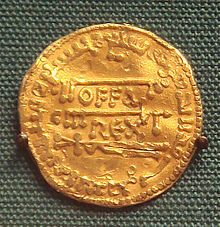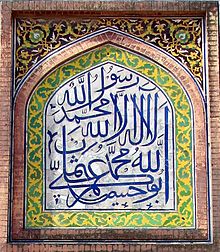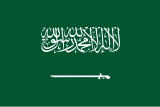Shahada

The Shahada (
The Shahada declares belief in the oneness (tawhid) of God and the acceptance of Muhammad as God's messenger. Some Shias also include a statement of belief in the wilayat of Ali.[1] A single honest recitation of the Shahada is all that is required for a person to become a Muslim according to most traditional schools.[2]
| Part of a series on |
| Islam |
|---|
 |
The testimonies
The declaration reads:[3][4][5][6]
لَا إِلَٰهَ إِلَّا ٱللَّٰهُ |
There is no deity but God. |
مُحَمَّدٌ رَسُولُ ٱللَّٰهِ |
Muhammad is the Messenger of God.
|
The above two statements are commonly prefaced by the phrase ašhadu ʾan ('I bear witness that'), yielding the full form:
أَشْهَدُ أَنْ لَا إِلَٰهَ إِلَّا ٱللَّٰهُ وَأَشْهَدُ أَنَّ مُحَمَّدًا رَسُولُ ٱللَّٰهِ |
I bear witness that there is no deity but God, and I bear witness that Muhammad is the Messenger of God.ⓘ |
Terminology and significance
The Shahada can be translated into English as "There is no god but God. Muhammad is the messenger of God."[7] In English, capitalization of a word's initial letter indicates that it is a proper noun; that is, the name of a unique entity. If it is a noun with a lower case initial letter it is a "common noun"; that is a name which is not unique to an entity, but, instead, could apply to a number of members of a set.[8] The orthography of the translation therefore replicates the original Arabic meaning so that god is a common noun and God is a unique proper name.[9]
The noun šahādah (شَهَادَة), from the verb šahida ([ʃa.hi.da] شَهِدَ), from the root š-h-d (ش-ه-د) meaning "to observe, witness, testify", translates as "testimony" in both the everyday and the legal senses.[10][note 2] The Islamic creed is also called, in the dual form, šahādatān (شَهَادَتَان, literally "two testimonies"). The expression al-šahīd (ٱلْشَّهِيد, "the Witness") is used in the Quran as one of the "titles of God".[14]
In Sunni Islam, the Shahada has two parts: 'lā ʾilāha ʾillā -llāh' ("There is no deity except God"), and 'muḥammadun rasūlu llāh' ("Muhammad is the Messenger of God"),[15] which are sometimes referred to as the first Shahada and the second Shahada.[16] The first statement of the Shahada is also known as the tahlīl.[17]
In
In the Quran, the first statement of the Shahadah takes the form lā ʾilāha ʾillā llāh twice (
Islam's monotheistic nature is reflected in the first sentence of the Shahada, which declares belief in the oneness of God and that he is the only entity truly worthy of worship.[16] The second sentence of the Shahada indicates the means by which God has offered guidance to human beings.[21] The verse reminds Muslims that they accept not only the prophecy of Muhammad but also the long line of prophets who preceded him.[21] While the first part is seen as a cosmic truth, the second is specific to Islam, as it is understood that members of the older Abrahamic religions do not view Muhammad as one of their prophets.[21]
The Shahada is a statement of both ritual and worship. In a well-known hadith, Muhammad defines Islam as witnessing that there is no deity but God and that Muhammad is God's Messenger, giving of alms (zakat), performing the ritual prayer, fasting during the month of Ramadan, and making a pilgrimage to the Kaaba: the Five Pillars of Islam are inherent in this declaration of faith.[16][22]
Recitation
| Part of a series on Aqidah |
|---|
 |
|
Including:
|
Recitation of the Shahadah is the most common
Origin
Though the two statements of the Shahada are both present in the Quran (for instance,
In Sufism
The Shahada has been traditionally recited in the Sufi ceremony of dhikr (Arabic: ذِکْر, "remembrance"), a ritual that resembles mantras found in many other religious traditions.[32] During the ceremony, the Shahada may be repeated thousands of times, sometimes in the shortened form of the first phrase where the word 'Allah' ("God") is replaced by 'huwa' ("Him").[32] The chanting of the Shahada sometimes provides a rhythmic background for singing.[33]
In architecture and art
The Shahada appears as an architectural element in Islamic buildings around the world, such as those in Jerusalem, Cairo, and Istanbul.[15][34][35]
Usage on flags

The Shahada is found on some
The
National flags with the Shahada
Gallery
 |
A mancus gold dinar of king Offa of Mercia, copied from the dinars of the Abbasid Caliphate (774); it includes the Arabic text "Muhammad is the Messenger of God". |
 |
The Qibla of the Fatimid caliph al-Mustansir Billah in the Mosque of Ibn Tulun, Cairo showing the Shia shahada that ends with the phrase "'Aliyyan Waliyyullah" ("Ali is the vicegerent of God") |
 |
The first phrase of the Shahada in kufic calligraphy (1309), Kashan, Iran |
 |
The Shia Shahada on the mausoleum of Attar of Nishapur, Iran. The first phrase is in white, the rest in blue. |
 |
Tile panel in the Wazir Khan Mosque, Lahore, Pakistan. The Shahada is on the top half of the panel. |
 |
Shahadas written in the style of a Mamluk tughra on the bottom right and in mirror image on bottom left
|
 |
The Shahada written in square Kufic script, shown as buildings topped with domes and minarets, with its mirror image on the left |
 |
Shia Shahadah at Fatimid Cairo with the phrase ʿAlīy walīy Allāh ("Ali is the vicegerent of God") at the end
|
See also
- Adhan
- Aqidah
- Bismala
- Dhikr
- Glossary of Islam
- Iqama
- Peace be upon him
- Salawat
- Shema Yisrael
- Six Kalimas
- Takbir
- Tashahhud
Notes
- ^ aš-šahādatāni (الشَّهَادَتَانِ, "the two testimonials"); also kalimatu š-šahādati (كَلِمَةُ ٱلشَّهَادَةِ, "the testimonial word")
- ^ The related noun šahīd ([ʃaˈhiːd] شَهِيد), which is used in the Quran mainly in the sense "witness", has paralleled in its development the Greek martys (μάρτυς) in that it may mean both "witness" and "martyr".[11][12] Similarly, šahāda may also mean "martyrdom" although in modern Arabic the more commonly used word for "martyrdom" is another derivative of the same root, istišhād (ٱسْتِشْهَاد).[13]
References
Citations
- ^ a b The Later Mughals by William Irvine p. 130
- ISBN 978-0-7614-7929-1.
- ISBN 978-0-674-01385-8. Archivedfrom the original on 25 September 2015. Retrieved 12 August 2015.
- ]
- ISBN 978-0-13-183563-4. Archivedfrom the original on 5 August 2018. Retrieved 11 September 2017.
- S2CID 159793899.
- ISBN 978-0-415-34882-9.
- ISBN 978-1-108-41577-4.
- ISBN 978-0-470-67420-8.
- ^ Wehr, Hans; J. Milton Cowan (1976). A Dictionary of Modern Written Arabic (PDF). pp. 488–489. Archived (PDF) from the original on 21 December 2015. Retrieved 26 November 2015.
- ISBN 9780195390155.
- ^ The Encyclopaedia of Islam, Volume IX, Klijkebrille, 1997, p. 201.
- ISBN 978-81-206-1768-1. Archivedfrom the original on 29 April 2016. Retrieved 26 November 2015.
- ^ a b c d Cornell 2007, p. 8.
- ^ a b c d e f g Lindsay 2005, p. 140–141.
- ^ a b c d Cornell 2007, p. 9.
- ISBN 978-1-883991-26-5.
- ^ Nasr et al (2015). The Study Quran. HarperOne. p. 110. (Footnote 255)
- ^ Nasr et al (2015). The Study Quran. HarperOne. p. 1356. (Footnote 22)
- Edip Yuksel, et al (2007). Quran: A Reformist Translation. Brainbrow Press. Footnote 3:18.
- ^ a b c d Cornell 2007, p. 10.
- ^ Lindsay 2005, p. 149.
- ^ "Seeking the Straight Path: Reflections of a New Muslim". Archived from the original on 16 July 2007. Retrieved 9 July 2007.
- ISBN 978-0-14-192086-3. Archivedfrom the original on 23 April 2016. Retrieved 27 November 2015.
- ^ ISBN 978-0-415-34888-1. Archivedfrom the original on 22 April 2016. Retrieved 27 November 2015.
- ^ ISBN 978-0-691-10099-9. Archivedfrom the original on 22 April 2016. Retrieved 27 November 2015.
- ^ Sahih al-Bukhari 8
- ^ Sahih Muslim 8a
- ^ Jami` at-Tirmidhi 2609
- ^ Sahih Muslim 16c
- ISSN 1613-0928.
- ^ ISBN 978-1-135-17960-1. Archivedfrom the original on 22 April 2016. Retrieved 27 November 2015.
- ISBN 978-0-8195-6798-7. Archivedfrom the original on 22 April 2016. Retrieved 27 November 2015.
- ISBN 978-90-04-09626-4. Archivedfrom the original on 22 April 2016. Retrieved 27 November 2015.
- ISBN 978-90-04-07611-2. Archivedfrom the original on 22 April 2016. Retrieved 27 November 2015.
- ISBN 978-1-4724-0991-1. Archivedfrom the original on 22 April 2016. Retrieved 27 November 2015.
- ISBN 978-90-04-08962-4.
- ^ ISBN 978-1-55297-813-9. Archivedfrom the original on 18 June 2018. Retrieved 19 March 2018.
- ^ "Saudi Arabia Flag and Description". World Atlas. Archived from the original on 22 June 2015. Retrieved 22 June 2015.
- ISBN 978-0-313-07696-1.
- ^ McCants, William (22 September 2015). "How ISIS Got Its Flag". The Atlantic. Archived from the original on 23 November 2015. Retrieved 23 November 2015.
Sources
- Cornell, Vincent J. (2007). Voices of Islam. ISBN 978-0-275-98733-6.
- Lindsay, James E. (2005). Daily Life in the Medieval Islamic World. ISBN 978-0-313-32270-9.
- Arthur J. Magida (18 October 2006). Opening the Doors of Wonder: Reflections on Religious Rites of Passage. University of California Press. ISBN 978-0-520-94171-7.
External links
- "The Shahadah as Truth and as Way" Archived 8 November 2014 at the Wayback Machine
- "Arabic phrases and about Islam". Essaouira. Archived from the original on 6 November 2014. Retrieved 12 July 2014.






